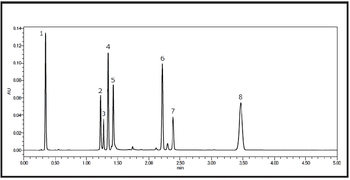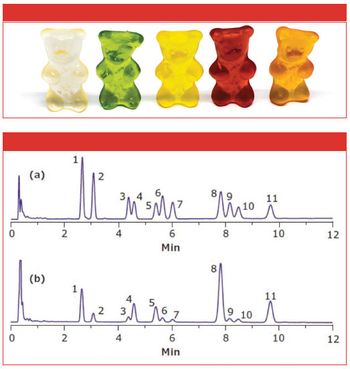
Metal-free columns should be considered when troubleshooting ion suppression. Chelating compounds that can form metal salt with stainless steel column housings are examined.

Metal-free columns should be considered when troubleshooting ion suppression. Chelating compounds that can form metal salt with stainless steel column housings are examined.

We recently introduced a new series of UHPLC columns with a particle size of 1.6 µm. Here we explain how to transfer an existing HPLC method to a new UHPLC method using polyphenols as an example.

Potency testing in marijuana-infused edibles is a problematic task due to the complexity of the matrices. The concentration of active ingredients in edibles can range from a few ppm to 3.5% (1). In this application, active cannabinoid compounds were extracted from gummy bears (and also brownies, results not shown), followed by HPLC analysis.

The European Pharmacopoeia (Ph. Eur.) defi nes requirements for the qualitative and quantitative composition of medicines, as well as the tests to be carried out on medicines and on substances and materials used in their production.

This method showed excellent precision and accuracy for the 12 FDA regulated mycotoxins that were evaluated during a validation study that covered a variety of matrices.

Organic arsenic compounds added to feed stocks of chicken and poultry pose serious environmental and ecological threats. National and worldwide health organizations, such as the U.S. Environmental Protection Agency and the U.S. Food and Drug Administration, have recently implemented more stringent concentration limits for arsenic species in drinking water and foodstuffs.

Living organisms (yeast and bacteria) were not identified as the agents that produced or spoiled common food items until the 19th century. Baking, especially of bread, was among the first industries to be transformed by the emerging scientific understanding of fermentation. The introduction of commercialized yeast in the early 20th century steadily reduced the time needed to bake bread both at home and on the production line, making way for modern packaged breads.

Determination of oligomeric states is an important issue in protein chemistry. For example, self-assembly via oligomerization domains is crucial for the regulation of several protein kinases. Determination of the oligomeric state of fragments of these kinases is a means of verifying the involvement of each domain in self-assembly.